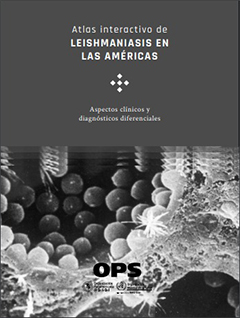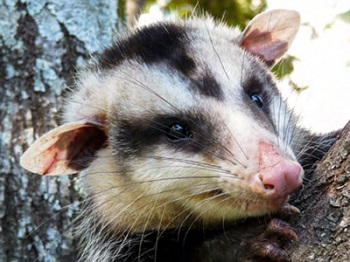Atlas offers knowledge on leishmaniasis in Americas
13/10/2020
Lucas Rocha (IOC/Fiocruz)
 In the American continent, leishmaniasis is caused by various species of parasites of the Leishmania genus. When infected, humans report a set of clinical manifestations that can compromise the skin, the mucous membranes, and internal organs. The different presentations of leishmaniasis are clinically mistaken for several other diseases, which makes its diagnosis a challenge for health workers. The varied clinical spectrum of the disease is also subject to the interaction of various factors regarding the parasite itself, the vector, and the host.
In the American continent, leishmaniasis is caused by various species of parasites of the Leishmania genus. When infected, humans report a set of clinical manifestations that can compromise the skin, the mucous membranes, and internal organs. The different presentations of leishmaniasis are clinically mistaken for several other diseases, which makes its diagnosis a challenge for health workers. The varied clinical spectrum of the disease is also subject to the interaction of various factors regarding the parasite itself, the vector, and the host.
Faced with the complexity of this scenario, the Pan-American Health Organization (PAHO) has published new material for managers and professionals of health services. The Interactive Atlas of Leishmaniasis in the Americas: differential clinical and diagnostic aspects tackles issues such as epidemiological situation, clinical manifestations, differential diagnosis, parasites, vectors, and reservoir animals, all in a practical manner. With photographs and illustrations that reflect the everyday work in health services, this publication offers professionals the possibility to research, get to know and analyze the content in an interactive fashion. The work also takes into account the clinical differences frequently found between endemic countries. The document, elaborated by PAHO in a partnership with the Ministry of Health of countries in the region and specialists, also includes the participation of researchers of the Oswaldo Cruz Institute (IOC/Fiocruz).
“This atlas is extremely relevant for the handling of leishmaniasis cases. This is an innovative work that discusses concepts and knowledge on the disease in countries in America, bringing together specificities of its different clinical forms and of more than 50 other diseases that are a differential diagnosis with leishmaniasis”, states Elizabeth Ferreira Rangel, vice-director of the IOC’s Reference and Biological Collections Laboratories, researcher of the Interdisciplinary Laboratory of Entomological Surveillance in Diptera and Hemiptera and coordinator of the National Reference Laboratory for the Ministry of Health and Regional Laboratory for the Pan-American Health Organization in Entomological Surveillance: Taxonomy and Ecology of Leishmaniasis Vectors. The specialist is also the coordinator of the Fiocruz Network of Leishmaniasis Laboratories.
Getting to know the parasites
“The document is part of a demand by the professionals who work directly at the leishmaniasis service. It is an important update for all countries where PAHO works, becoming a reference especially as it provides high-quality information and in a very objective manner”, points Elisa Cupolillo, curator of the Reference in Identification and Genotyping of Leishmania for the Ministry of Health and the PAHO.
Author of the chapter on the parasites that cause human leishmaniasis in the Americas, the IOC researcher emphasizes that knowledge on the different aspects of the species is crucial to fight the disease. “The parasites can cause various levels of impact, from therapeutic response to clinical development. Some species are linked to milder forms of the disease, while others cause more aggressive forms, such as the Leishmania braziliensis. Identification thus makes it possible to direct healthcare in a more suitable manner, for instance”, she says.
Among the highlights of the chapter are the description of new species, taxonomy revisions, and updates on the epidemiological situation and on the presence of parasites in different countries in the continent. For the researcher, the atlas brings closer together scientific research and a wide range of public health professionals involved with leishmaniasis, including those in charge of direct care of patients, of diagnosis, and of collecting the phlebotominae - the vector insects - in the field. “The association between research and service is important, as this integration gives rise to questions and demands that can contribute to a better diagnosis or to the definition of more effective therapeutic regimens”, she adds.
Reservoirs and maintenance of parasites in nature
Groups of species responsible for keeping a parasite in nature are called reservoirs. In the Atlas, researchers Ana Maria Jensen and André Roque, of the Trypanosomatids Biology Laboratory of IOC/Fiocruz, describe the main aspects of leishmaniasis reservoirs.
Roque highlights that Leishmania species are spread in different American habitats and biomes, and infect a great diversity of species of wild mammals in addition to humans and dogs. According to the researcher, with the exception of Leishmania infantum, these parasites have been in circulation among wild fauna for millions of years, even before humans first stepped in the American continent.
 The chapter highlights species pointed as potential reservoirs, such as opossums (Didelphis sp.), crab-eating fox (Cerdocyon thous), armadillos (Dasypus novemcintus), dogs, sloths, and rodents, with different species of Leishmania. “The peculiarities of the interaction between parasite and host, especially when it comes to the potentiality of this host as a source of infection for the vector, will define their role as reservoirs. This role is not a fixed attribute of a host, and, as it depends on the parasite-host interaction, it also varies over time and place”, explains Roque.
The chapter highlights species pointed as potential reservoirs, such as opossums (Didelphis sp.), crab-eating fox (Cerdocyon thous), armadillos (Dasypus novemcintus), dogs, sloths, and rodents, with different species of Leishmania. “The peculiarities of the interaction between parasite and host, especially when it comes to the potentiality of this host as a source of infection for the vector, will define their role as reservoirs. This role is not a fixed attribute of a host, and, as it depends on the parasite-host interaction, it also varies over time and place”, explains Roque.
For the authors, in addition to contributing to the clinical approach and the differential diagnosis of patients, the contents of the atlas show the complexity of this parasitic disease and the importance of assessing the variables related to the disease in a joint manner. “Leishmaniasis are zoonosis dispersed in wild environments. Humans are just another host of their transmission cycle and are normally what we call end-of-line hosts in the transmission cycle. In order to propose control and prevention measures for such a complex parasitic disease, it is essential to advance in the knowledge of all actors involved in the transmission: parasites, vectors, reservoirs and the environment where they are included”, concluded Jansen.


